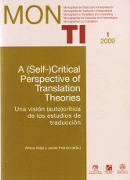Old concepts, new ideas: approaches to translation shifts
##plugins.themes.bootstrap3.article.main##
Resum
This paper traces the development of the translation shift concept from its origins in the linguistics-oriented era of translation studies to its current revival in computer-based approaches: after a presentation of the traditional approaches by John C. Catford, Jean-Paul Vinay and Jean Darbelnet, Eugene A. Nida, and Kitty van Leuven-Zwart, several recent studies that have integrated the concept of translation shifts are introduced and discussed. This comparison of old and new approaches reveals that the attitudes towards shifts have changed from mildly prescriptive to neutrally descriptive. The paper concludes with a general evaluation of the place of linguistic approaches in translation studies.
Dieser Artikel untersucht die Entwicklung des Shift-Konzepts von seinen Ursprüngen in der linguistisch orientierten Phase der Übersetzungswissenschaft bis hin zu seiner derzeitigen Neubelebung in computerbasierten Ansätzen. Es werden zunächst die traditionellen Ansätze von John C. Catford, Jean-Paul Vinay und Jean Darbelnet, Eugene A. Nida sowie Kitty van Leuven-Zwart dargestellt und dann einige neuere Untersuchungen, die sich mit dem Shift-Konzept befassen, vorgestellt und diskutiert. Durch diese Gegenüberstellung wird deutlich, dass die präskriptiven Standpunkte mittlerweile einer neutral deskriptiven Herangehensweise gewichen ist. Der Artikel endet mit einer generellen Einschätzung des Stellenwerts linguistischer Ansätze in der Übersetzungswissenschaft.
Descàrregues
##plugins.themes.bootstrap3.article.details##
La propietat intel·lectual dels articles pertany als autors i els drets d'edició i publicació, a la revista. Els articles publicats en la revista podran ser utilitzats lliurement per a propòsits educatius i científics, sempre que se'n faça una correcta citació. Qualsevol ús comercial és expressament penat per la llei.
Referències
Ahrenberg, Lars & Magnus Merkel. (2000) “Correspondence Measures for MT Evaluation.” In: Proceedings of the Second International Conference on Linguistic Resources and Evaluation (LREC-2000). Athens, Greece. pp. 1255-1261.
Baker, Mona. (1995) “Corpora in Translation Studies: An Overview and Some Suggestions for Future Research.” Target 7:1. pp. 223-243.
Bakker, Matthijs; Cees Koster & Kitty van Leuven-Zwart. (1998) “Shifts of Translation.” In: Baker, Mona (ed.) 1998. Routledge Encyclopedia of Translation Studies. London: Routledge. pp. 226-231.
Catford, John C. (1965) A Linguistic Theory of Translation: An Essay in Applied Linguistics. Oxford: Oxford University Press.
Chesterman, Andrew (ed.). (1989) Readings in Translation Theory. Helsinki: Oy Finn Lecture Ab.
Cyrus, Lea. (2006) “Building a Resource for Studying Translation Shifts.” In: Proceedings of the Fifth International Conference on Linguistic Resources and Evaluation LREC-2006). Genoa, Italy. pp. 1240-1245.
Halliday, Michael Alexander Kirkwood. (1961) “Categories of the Theory of Grammar.” Word 17:3. pp. 241-292.
Kade, Otto. (1968) Zufall und Gesetzmäßigkeit in der Übersetzung. Beihefte zur Zeitschrift Fremdsprachen. Leipzig: VEB Verlag Enzyklopädie.
Kenny, Dorothy. (1998) “Equivalence.” In: Baker, Mona (ed.) 1998. Routledge Encyclopedia of Translation Studies. London: Routledge. pp. 77-80.
Koehn, Philipp. (2002) Europarl: A Multilingual Corpus for Evaluation of Machine Translation. Unpublished draft at http://people.csail.mit.edu/people/koehn/publications/europarl/.
Laviosa, Sara. (2002) Corpus-based Translation Studies: Theory, Findings, Applications. Amsterdam, Rodopi.
van Leuven-Zwart, Kitty M. (1989) “Translation and Original: Similarities and Dissimilarities, I.” Target 1:2. pp. 151-181.
van Leuven-Zwart, Kitty M. (1990a) “Translation and Original: Similarities and Dissimilarities, II.” Target 2:1. pp. 69-95.
van Leuven-Zwart, Kitty M. (1990b) “Shifts of Meaning in Translation: Do’s or Don’ts?” In: Thelen, Marcel & Barbara Lewandowska-Tomaszczyk (eds.) 1990. Translation and Meaning, Part 1. Maastricht: Euroterm. pp. 226-233.
Macken, Lieve. (2007) “Analysis of Translational Correspondence in View of Subsentential Alignment.” In: Proceedings of the METIS-II Workshop on New Approaches to Machine Translation. Leuven, Belgium.
Mauranen, Anna & Pekka Kujamäki (eds.) (2004) Translation Universals: Do they Exist? Amsterdam, Benjamins.
Munday, Jeremy. (1998) “A Computer-Assisted Approach to the Analysis of Translation Shifts.” Meta 43:4. pp. 142-156.
Nida, Eugene Albert. (1964) Toward a Science of Translation. Leiden: Brill.
Olohan, Maeve. (2004) Introducing Corpora in Translation Studies. London, Routledge.
Snell-Hornby, Mary. (1990) “Linguistic Transcoding or Cultural Transfer? A Critique of Translation Theory in Germany.” In: Bassnett, Susan & André Lefevere (eds.) 1990. Translation, History and Culture. London: Pinter. pp. 79-86.
Snell-Hornby, Mary. (2006) The Turns of Translation Studies. Amsterdam: Benjamins.
Störig, Hans Joachim (ed.) (1963) Das Problem des Übersetzens. Darmstadt: Wissenschaftliche Buchgesellschaft.
Toury, Gideon. (1980) In Search of a Theory of Translation. Tel Aviv: Porter Institute.
Toury, Gideon. (1995) Descriptive Translation Studies and Beyond. Amsterdam: Benjamins.
Toury, Gideon. (2004) “Probabilistic Explanations in Translation Studies: Welcome as they are, would they Qualify as Universals?” In: Mauranen, Anna & Pekka Kujamäki (eds.) 2004. pp. 15-32.
Vinay, Jean-Paul & Jean Darbelnet. (1958) Stylistique Comparée du Français et de l’Anglais: Méthode de Traduction. Paris: Didier.


